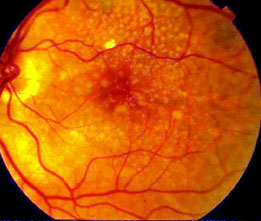 Age-related macular degeneration (ARMD) is a progressive disease of the retina that causes blurring of your central. The blurring happens because of damage to the macula, a small area at the back of the eye.
Age-related macular degeneration (ARMD) is a progressive disease of the retina that causes blurring of your central. The blurring happens because of damage to the macula, a small area at the back of the eye.
The macula helps you see the fine detail in things that your eyes are focusing on.
Macular degeneration makes it harder to do things that require sharp central vision, like reading, driving, and recognizing faces. It does not affect the side (peripheral) vision, so it does not lead to complete blindness.
The disease is thought to be caused by a combination of genetic and environmental factors, and it is most common in people who are over 60 years old.
ARMD is the leading cause of visual impairment in senior citizens. An estimated fifteen million people in the United States have it, and approximately two million new cases are diagnosed annually.
There are Two Types of Macular Degeneration: Wet and Dry
The dry form is by far the most common type. The wet form is much less common, but it happens more quickly and is more severe.
Dry ARMD
Dry ARMD accounts for about 9 out of 10 cases of macular degeneration. It develops slowly and causes the central vision to become dimmer or more blurry over time. It usually does not cause severe vision loss unless it turns into a wet form.
Wet ARMD
Wet ARMD accounts for only about 1 out of 10 cases of macular degeneration. It can cause serious vision loss within months or even weeks. People who have the wet form have the dry form first.
You may have either type in just one eye, but over time you may get it in the other eye too.

If you have the wet form of macular degeneration, you may have one or more of the following treatments:
- Photodynamic therapy
- Injections of medicine into your eye
- Laser surgery
These treatments can’t restore central vision, but they may slow down vision loss. If Dr. McMickle recommends one of these treatments, it is important to have it done right away.

